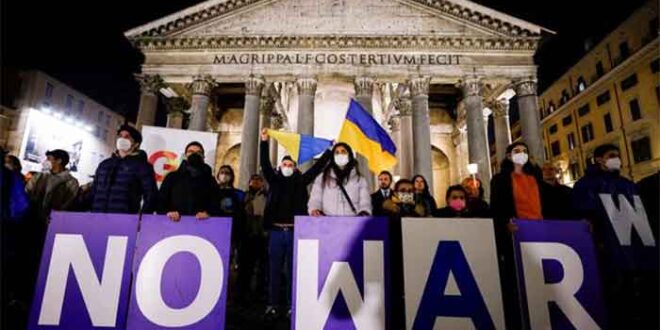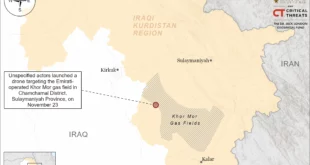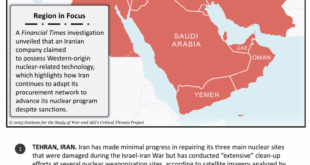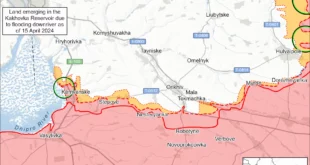Every day brings new noise and fury in the crisis over Ukraine, mostly from Washington. But what is really likely to happen?
There are three possible scenarios:
The first is that Russia will suddenly launch an unprovoked invasion of Ukraine.
The second is that the Ukrainian government in Kyiv will launch an escalation of its civil war against the self-declared People’s Republics of Donetsk (DPR) and Luhansk (LPR), provoking various possible reactions from other countries.
The third is that neither of these will happen, and the crisis will pass without a major escalation of the war in the short term.
So who will do what, and how will other countries respond in each case?
Unprovoked Russian invasion
This seems to be the least likely outcome.
An actual Russian invasion would unleash unpredictable and cascading consequences that could escalate quickly, leading to mass civilian casualties, a new refugee crisis in Europe, war between Russia and NATO, or even nuclear war.
If Russia wanted to annex the DPR and LPR, it could have done so amid the crisis that followed the U.S.-backed coup in Ukraine in 2014. Russia already faced a furious Western response over its annexation of Crimea, so the international cost of annexing the DPR and LPR, which were also asking to rejoin Russia, would have been less then than it would be now.
Russia instead adopted a carefully calculated position in which it gave the Republics only covert military and political support. If Russia was really ready to risk so much more now than in 2014, that would be a dreadful reflection of just how far U.S.-Russian relations have sunk.
If Russia does launch an unprovoked invasion of Ukraine or annex the DPR and LPR, Biden has already said that the United States and NATO would not directly fight a war with Russia over Ukraine, although that promise could be severely tested by the hawks in Congress and a media hellbent on stirring up anti-Russia hysteria.
However, the United States and its allies would definitely impose heavy new sanctions on Russia, cementing the Cold War economic and political division of the world between the United States and its allies on one hand, and Russia, China and their allies on the other. Biden would achieve the full-blown Cold War that successive U.S. administrations have been cooking up for a decade, and which seems to be the unstated purpose of this manufactured crisis.
In terms of Europe, the U.S. geopolitical goal is clearly to engineer a complete breakdown in relations between Russia and the European Union (EU), to bind Europe to the United States. Forcing Germany to cancel its $11 billion Nord Stream 2 natural gas pipeline from Russia will certainly make Germany more energy dependent on the U.S. and its allies. The overall result would be exactly as Lord Ismay, NATO’s first Secretary General, described when he said that the purpose of the alliance was to keep “the Russians out, the Americans in and the Germans down.”
Brexit (the U.K. departure from the EU) detached the U.K. from the EU and cemented its “special relationship” and military alliance with the United States. In the current crisis, this joined-at-the-hip U.S.-U.K. alliance is reprising the unified role it played to diplomatically engineer and wage wars on Iraq in 1991 and 2003.
Today, China and the European Union (led by France and Germany) are the two leading trade partners of most countries in the world, a position formerly occupied by the United States. If the U.S. strategy in this crisis succeeds, it will erect a new Iron Curtain between Russia and the rest of Europe to inextricably tie the EU to the United States and prevent it from becoming a truly independent pole in a new multipolar world. If Biden pulls this off, he will have reduced America’s celebrated “victory” in the Cold War to simply dismantling the Iron Curtain and rebuilding it a few hundred miles to the east 30 years later.
But Biden may be trying to close the barn door after the horse has bolted. The EU is already an independent economic power. It is politically diverse and sometimes divided, but its political divisions seem manageable when compared with the political chaos, corruption and endemic poverty in the United States. Most Europeans think their political systems are healthier and more democratic than America’s, and they seem to be correct.
Like China, the EU and its members are proving to be more reliable partners for international trade and peaceful development than the self-absorbed, capricious and militaristic United States, where positive steps by one administration are regularly undone by the next, and whose military aid and arms sales destabilize countries (as in Africa right now), and strengthen dictatorships and extreme right-wing governments around the world.
But an unprovoked Russian invasion of Ukraine would almost certainly fulfill Biden’s goal of isolating Russia from Europe, at least in the short term. If Russia was ready to pay that price, it would be because it now sees the renewed Cold War division of Europe by the United States and NATO as unavoidable and irrevocable, and has concluded that it must consolidate and strengthen its defenses. That would also imply that Russia has China’s full support for doing so, heralding a darker and more dangerous future for the whole world.
Ukrainian escalation of civil war
The second scenario, an escalation of the civil war by Ukrainian forces, seems more likely.
Whether it is a full-scale invasion of the Donbas or something less, its main purpose from the U.S. point of view would be to provoke Russia into intervening more directly in Ukraine, to fulfill Biden’s prediction of a “Russian invasion” and unleash the maximum pressure sanctions he has threatened.
While Western leaders have been warning of a Russian invasion of Ukraine, Russian, DPR and LPR officials have been warning for months that Ukrainian government forces were escalating the civil war and have 150,000 troops and new weapons poised to attack the DPR and LPR.
In that scenario, the massive U.S. and Western arms shipments arriving in Ukraine on the pretext of deterring a Russian invasion would in fact be intended for use in an already planned Ukrainian government offensive.
On one hand, if Ukrainian President Zelensky and his government are planning an offensive in the East, why are they so publicly playing down fears of a Russian invasion? Surely they would be joining the chorus from Washington, London and Brussels, setting the stage to point their fingers at Russia as soon as they launch their own escalation.
And why are the Russians not more vocal in alerting the world to the danger of escalation by Ukrainian government forces surrounding the DPR and LPR? Surely the Russians have extensive intelligence sources inside Ukraine and would know if Ukraine was indeed planning a new offensive. But the Russians seem much more concerned by the breakdown in U.S.-Russian relations than in what the Ukrainian military may be up to.
On the other hand, the U.S., U.K. and NATO propaganda strategy has been organized in plain sight, with a new “intelligence” revelation or high-level pronouncement for every day of the month. So what might they have up their sleeves? Are they really confident that they can wrong-foot the Russians and leave them carrying the can for a deception operation that could rival the Tonkin Gulf incident or the WMD lies about Iraq?
The plan could be very simple. Ukrainian government forces attack. Russia comes to the defense of the DPR and LPR. Biden and Boris Johnson scream “Invasion,” and “We told you so!” Macron and Scholz mutely echo “Invasion,” and “We stand together.” The United States and its allies impose “maximum pressure” sanctions on Russia, and NATO’s plans for a new Iron Curtain across Europe are a fait accompli.
An added wrinkle could be the kind of “false flag” narrative that U.S. and U.K. officials have hinted at several times. A Ukrainian government attack on the DPR or LPR could be passed off in the West as a “false flag” provocation by Russia, to muddy the distinction between a Ukrainian government escalation of the civil war and a “Russian invasion.”
It’s unclear whether such plans would work, or whether they would simply divide NATO and Europe, with different countries taking different positions. Tragically, the answer might depend more on how craftily the trap was sprung than on the rights or wrongs of the conflict.
But the critical question will be whether EU nations are ready to sacrifice their own independence and economic prosperity, which depends partly on natural gas supplies from Russia, for the uncertain benefits and debilitating costs of continued subservience to the U.S. empire. Europe would face a stark choice between a full return to its Cold War role on the front line of a possible nuclear war and the peaceful, cooperative future the EU has gradually but steadily built since 1990.
Many Europeans are disillusioned with the neoliberal economic and political order that the EU has embraced, but it was subservience to the United States that led them down that garden path in the first place. Solidifying and deepening that subservience now would consolidate the plutocracy and extreme inequality of U.S.-led neoliberalism, not lead to a way out of it.
Biden may get away with blaming the Russians for everything when he’s kowtowing to war-hawks and preening for the TV cameras in Washington. But European governments have their own intelligence agencies and military advisors, who are not all under the thumb of the CIA and NATO. The German and French intelligence agencies have often warned their bosses not to follow the U.S. pied piper, notably into Iraq in 2003. We must hope they have not all lost their objectivity, analytical skills or loyalty to their own countries since then.
If this backfires on Biden, and Europe ultimately rejects his call to arms against Russia, this could be the moment when Europe bravely steps up to take its place as a strong, independent power in the emerging multipolar world.
Nothing happens
This would be the best outcome of all: an anti-climax to celebrate.
At some point, absent an invasion by Russia or an escalation by Ukraine, Biden would sooner or later have to stop crying “Wolf” every day.
All sides could climb back down from their military build-ups, panicked rhetoric and threatened sanctions.
The Minsk Protocol could be revived, revised and reinvigorated to provide a satisfactory degree of autonomy to the people of the DPR and LPR within Ukraine, or facilitate a peaceful separation.
The United States, Russia and China could begin more serious diplomacy to reduce the threat of nuclear war and resolve their many differences, so that the world could move forward to peace and prosperity instead of backwards to Cold War and nuclear brinkmanship.
Conclusion
However it ends, this crisis should be a wake-up call for Americans of all classes and political persuasions to reevaluate our country’s position in the world. We have squandered trillions of dollars, and millions of other people’s lives, with our militarism and imperialism. The U.S. military budget keeps rising with no end in sight–and now the conflict with Russia has become another justification for prioritizing weapons spending over the needs of our people.
Our corrupt leaders have tried but failed to strangle the emerging multipolar world at birth through militarism and coercion. As we can see after 20 years of war in Afghanistan, we cannot fight and bomb our way to peace or stability, and coercive economic sanctions can be almost as brutal and destructive. We must also re-evaluate the role of NATO and wind down this military alliance that has become such an aggressive and destructive force in the world.
Instead, we must start thinking about how a post-imperial America can play a cooperative and constructive role in this new multipolar world, working with all our neighbors to solve the very serious problems facing humanity in the 21st Century.
 Eurasia Press & News
Eurasia Press & News



